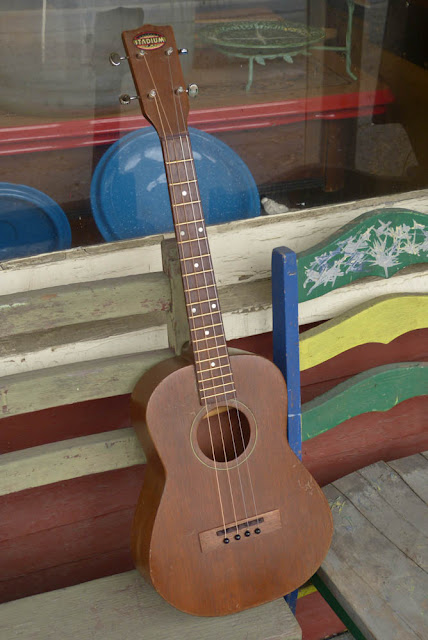1950s United-made Stadium Tenor Guitar Conversion
Update: A long time ago someone planted the idea of converting a baritone uke to a tenor guitar -- and I'd waited for the right "subject" to come along. I've converted this to a mini tenor guitar and so I've updated the post information and pics.
Like the Wabash and Bobby Henshaw model baritone ukes, this one was more than likely made by United in New Jersey. These ukes have a 19" scale and a shape sort-of like a Favilla baritone, though the construction is stiffer and heavier -- on the order of a Harmony bari. The sound, though, is mostly the mellow-but-sustained voice of a Harmony but with a bit more scope on the lower-mids due to the wider soundboard and extra air in the body. These also feature a slightly thicker (front/back) neck which has enabled me -- on this one -- to convert it to a steel-strung tenor guitar without any ill-will transferred to the instrument. As of updating the post it's been strung-up for 2 weeks with steel (tuned DGBE) and is stable, with a straight neck, and good to go.
Like the Wabash and Bobby Henshaw model baritone ukes, this one was more than likely made by United in New Jersey. These ukes have a 19" scale and a shape sort-of like a Favilla baritone, though the construction is stiffer and heavier -- on the order of a Harmony bari. The sound, though, is mostly the mellow-but-sustained voice of a Harmony but with a bit more scope on the lower-mids due to the wider soundboard and extra air in the body. These also feature a slightly thicker (front/back) neck which has enabled me -- on this one -- to convert it to a steel-strung tenor guitar without any ill-will transferred to the instrument. As of updating the post it's been strung-up for 2 weeks with steel (tuned DGBE) and is stable, with a straight neck, and good to go.
It had some work done to it in the past (functional but clumsy neck reset) but I cleaned that up, recut the bridge and installed a new rosewood saddle, gave it a fret level/dress, cleated/sealed a crack in the back, made a new rosewood nut, installed a set of Kluson-style guitar tuners, and set it up. It plays spot-on with hair-above 1/16" action at the 12th fret and is strung 32w, 22w, 16, 12 for DGBE tuning.
This is all-solid mahogany with Brazilian rosewood board and bridges. The bracing is ladder-style and gives a fun, 20s-sounding tone to it with the steel installed.
I'm pretty-much installing Kluson-style repro tuners as a standard-issue thing on instruments like this. It makes life easier for the average player.
The board and bridge appear to be Brazilian rosewood. The dots are pearl (nice!) and the frets are brass and in good order.
The bridge may look slightly awkward but it's because I had to 1) convert it from a classical-style "tie block" bridge to a pin-bridge and 2) install a big enough compensated saddle to let it intonate correctly. The original saddle slot was actually cut about 1/16" too far forward so I expanded it to the rear and made the oversize rosewood saddle for it. It works!
There's actually a bridge plate under there so the ball-ends sit nice and snug in their new pin-holes.
Here you can see the evidence of the old reglue job on the neck. I tidied it a bit but it's obvious that it was off at some point.
There's a long, repaired, hairline crack on the back and plenty of use-wear all over.
An original bag comes with it, though the zipper is shot and will require replacement (or maybe snaps instead?) if it's to be used for anything but storage.


















Comments
thank you
ron
PS..I found your link on Toby's site